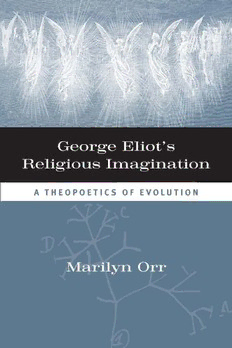
George Eliot's religious imagination: a theopoetics of evolution PDF
Preview George Eliot's religious imagination: a theopoetics of evolution
George Eliot’s Religious Imagination George Eliot’s Religious Imagination A Theopoetics of Evolution Marilyn Orr northwestern university press evanston, illinois Northwestern University Press www.nupress.northwestern.edu Copyright © 2018 by Northwestern University Press. Published 2018. All rights reserved. Printed in the United States of America 10 9 8 7 6 5 4 3 2 1 Library of Congress Cataloging- in- Publication Data Names: Orr, Marilyn, 1950– author. Title: George Eliot’s religious imagination : a theopoetics of evolution / Marilyn Orr. Description: Evanston, Illinois : Northwestern University Press, 2017. | Includes bibliographical references and index. Identifiers: LCCN 2017029797 | ISBN 9780810135895 (cloth : alk. paper) | ISBN 9780810135888 (pbk. : alk. paper) | ISBN 9780810135901 (e-book) Subjects: LCSH: Eliot, George, 1819–1880—Criticism and interpretation. | Eliot, George, 1819–1880—Religion. | Evolution (Biology)—Religious aspects— Christianity. Classification: LCC PR4692.R4 O77 2017 | DDC 823.8—dc23 LC record available at https://lccn.loc.gov/2017029797 It is perhaps the business of the commentator and critic to point to resemblances, as well as to differences, between the form of thought of a poet of the past, and our own, for it seems that unless this is done, and done repeatedly from generation to generation, works of the past cease to have significance for the ordinary reader, which is tantamount to saying they cease to live. — Barbara Reynolds, “Introduction” to Dante, Paradiso, 15 Ring the bells that still can ring. Forget your perfect offering. There is a crack, a crack in everything. That’s how the light gets in. — Leonard Cohen, “Anthem” Contents Preface ix Acknowledgments xiii Introduction 3 Chapter 1 Incarnation and Inwardness: George Eliot’s Early Works in the Context of Contemporary Religious Debates 11 Chapter 2 “Even Our Failures Are a Prophecy”: Toward a Post- Evangelical Aesthetic 33 Chapter 3 Religion in a Secular World: Middlemarch and the Mysticism of the Everyday 59 Chapter 4 “The Religion of the Future”: Daniel Deronda and the Mystical Imagination 87 Chapter 5 Evolutionary Spirituality and the Theopoetical Imagination: George Eliot and Teilhard de Chardin 109 Conclusion The Word Continuously Incarnated 135 Notes 139 Bibliography 165 Index 171 Preface I have always been finding out my religion since I was a little girl. —D orothea in Middlemarch, 4:39, 387 When I think of how I came to produce this book, I find myself encounter- ing a number of friends, mentors, colleagues, and family members who have lighted my way. I think of Teilhard de Chardin’s idea— whose affinity with George Eliot in reference to this and much else I discuss in chapter 5— that while each individual consciousness is an “absolutely original centre,” each center becomes more and more itself as it is drawn constantly and increas- ingly “into association with all the centres”; each self becomes more and more, not less and less, itself “by convergence” with other selves.1 If I have become more myself by converging with other selves I have also come to understand, in the course of writing this book, more about conver- gence itself, a concept that increasingly delighted and enthralled George Eliot and is a key theme in her last novel, Daniel Deronda. Convergence, Teilhard would say, increases complexity, and increased complexity leads, for those who are open to it, to increased consciousness. Indeed, coming to understand this and learning how to act upon this awareness is one way of describing the evolution that Dorothea undergoes in Middlemarch. George Eliot’s ever- increasing understanding of and belief in convergence, which I explore mainly in chapter 4, is one of the key elements of what I am calling her “religious imagination.” Convergence is crucial to her religious imagination particularly because she sees it as affirming the power of imagi- nation in various forms. Along with convergence, the three main components of her religious imagination are inwardness, incarnation, and integration. All four of these elements develop according to evolution, which Teilhard calls “the light illuminating all facts.”2 Inwardness and incarnation are my two main themes in chapter 1, but in chapter 2 I show how George Eliot’s understanding of them evolves such that they move from being themes in her work to becoming essential to her own being and practice. Another way to describe what she learns through her writing at this stage is the power of integration (my main focus in chapter 3), as she comes to experience her own integral relation with her characters and their stories. This insight comes at a cost, and underlying and informing George Eliot’s religious imagination in all four of these elements is an ever-e volving understanding of suffering. From the start of her career she shares Kierkegaard’s understanding that suffering, ix
